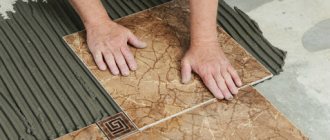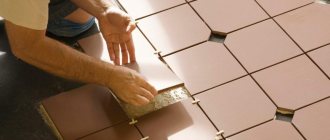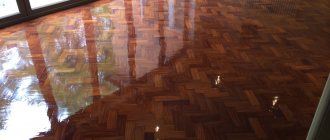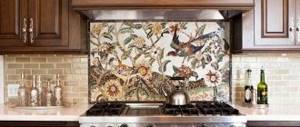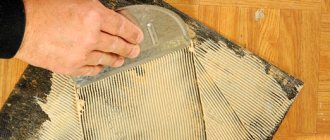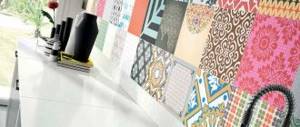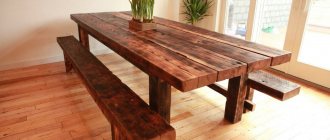What determines the standard size of floor tiles?
There are three main modern types of floor tiles.
- Ceramics - this includes both plain, even square panels, and mosaic elements or their imitation. This is the option with the widest price range - from cheap serial issues to rare broomsticks or products in the Moroccan or Portuguese style (“azulejo”).
- Porcelain tiles are more expensive than ceramics in the basic version, more durable. Depending on the complexity of the design and additional additives, the price increases. Popular sizes – from 30x30 cm.
- Quartzvinyl is a composite material made of PVC and quartz chips. Durable, lightweight, easy to install (easily glued or connected with locks, much easier to adjust to the required parameters).
Separately, you can select tiles that imitate a wooden floor or parquet. At first its size did not differ from large slabs, but later their geometry became closer to the wooden original. So, the following panels look most natural (in centimeters):
- 15x45;
- 12x60;
- 15x60;
- 19x60;
- 20x60;
- 14x66;
- 15x66.
Gender question: which is better, laminate or parquet?
What is the difference between parquet and laminate, which is better?
Porcelain stoneware is stronger than ceramics, so panels made from it tend to be larger in area. Metlakh tiles, which can be laid out in a pattern, can have a variety of parameters, but mostly small ones.
The dimensions of quartz vinyl largely depend on the design and method of connection, but most often these panels are larger than porcelain stoneware.
"Wooden" ceramic tiles
Fashion trends demanded that ceramic products with a “wood” look appear on the market. Its appearance and dimensions are similar in texture and color to a standard parquet board. In addition, the length gives the material some fragility. To offset this drawback, such a tile is made from highly fired porcelain stoneware.
Consumers prefer “wooden” tiles in sizes 15x45, 12x60 and 2x60 cm. The length of such a “board” for the floor can be up to 150 cm. And the thickness of the ceramic part can be 7-11 mm. Video details about wood-look flooring, through the eyes of a specialist.
What sizes are ceramic floor tiles?
Ceramics are more fragile than porcelain stoneware, so if they are laid carelessly - if voids have formed in the cement - cracks may appear. If we are talking about mosaics or rare tiles (the same broom), then small volumes allow you to buy exactly as much as is needed for the room, thereby saving money and avoiding a lot of cutting.
Various manufacturers are trying to create exclusive products, so they are actively promoting lines with non-standard sizes and designs. However, almost all ceramic floor panels have standard parameters (length and width in centimeters):
- 10x10;
- 10x20;
- 15x15;
- 20x20;
- 30x30.
These parameters can fit both ordinary products and designer samples. Ceramics are often chosen for rooms where the load is light, such as the bathroom and toilet. Here the coating is less susceptible to abrasion, excessive weight and impact loads: unlike in the kitchen, there is no risk, for example, of dropping a heavy frying pan.
Porcelain tiles with regular thickness
Porcelain tile thickness
The most common category of porcelain stoneware slabs, thickness ranges from 7–14 mm. In terms of physical indicators and operational characteristics, they meet the requirements of developers. The slabs are universally used and are used as finishing floor coverings for premises for various purposes, from residential to government, commercial, office and industrial buildings. The sizes of the slabs range from 50×50 mm to 600×600 mm, they are perfectly processed with the simplest tools, the laying technology is ordinary.
Formats and thickness
Existing state regulatory documents SP 29.13330.2011 establish the minimum strength of slabs within 200 kg/cm2, specific values are tied to the intensity of loads on floor coverings. A fairly large thickness makes it possible to expand the range of materials; tiles with a standard thickness can be:
- technical. The cheapest, used for the construction of floors in industrial and warehouse premises. Thickness is at least 10 mm, the front surface is not further processed after annealing. They do not react with aggressive chemical compounds; due to the rough surface, the sliding effect is eliminated - the operation of loading/unloading mechanisms is facilitated, and the risk of personnel falls is minimized;
- glazed. One of the most expensive types of porcelain stoneware, an additional layer is applied before firing, which allows you to create various decorative solutions for front surfaces. Used for residential premises, can be found in prestigious halls for various purposes;
- matte. The front surface after annealing is only ground with coarse-grained wheels. Non-slip, relatively low cost, universal use;
- polished. The material is of the highest class, and is much more expensive than the brands described above. Disadvantage: inability to use in open areas;
- structured. The thickness of such slabs is at least 10 mm; on thinner ones, a significant decrease in physical strength indicators is possible due to a significant decrease in thickness in places of volumetric relief. The front surface can imitate natural parquet, fabric, leather, etc. The surface can be processed using various methods, from ordinary etching to applying a layer of gold leaf.
Tiles with ordinary thickness are used for finishing floors inside and outside buildings; they can be laid in subways and supermarkets, in residential apartments and prestigious offices, in concert and sports halls, airports, train stations, etc. According to the vast majority of professional builders, the use of porcelain stoneware slabs of standard thickness are a justified and cost-effective solution.
Choosing floor coverings in the kitchen and bathroom: which is better, porcelain tiles or ceramic tiles?
Today, porcelain tiles are considered the most optimal for cladding facades and flooring, and are gradually displacing the usual tiles from this niche. What is the secret of this fairly new material?
First of all, I would like to note that the composition of porcelain stoneware or ceramic tiles is practically indistinguishable. Both of these materials are made from the same raw materials. The difference lies in its more complex processing, which determines the properties of the finished tile. After molding, by pressing and pre-drying, the mass is exposed to high temperatures, which leads to sintering and the formation of a monolith. That is, the finished material is much closer in its properties to natural stone.
Porcelain stoneware floor tiles do not have pores, cavities, or microcracks. Therefore, it does not absorb moisture and does not collapse when frozen. In addition, due to the homogeneity of the material and the strong bonds inside it, porcelain stoneware is more resistant to mechanical damage. It can withstand greater loads than the most durable floor tiles. Some types of porcelain floor tiles are suitable for finishing industrial premises and pedestrian areas.
In addition, the material is homogeneous throughout its entire thickness. This quality not only determines its resistance to high loads, but also to abrasion. Due to the fact that the pattern is uniform throughout the entire thickness of each tile. It will not wear off even in high traffic conditions.
Of course, in addition to its advantages, porcelain floor tiles also have some disadvantages compared to floor tiles. Firstly, this refers to the variety of colors and patterns. Most types of porcelain tiles have natural shades, plain colors or simple textures. Not long ago, tiles with three-dimensional patterns appeared. The second most important drawback, which is also an advantage, is strength. These tiles are more difficult to work with than tiles. The complexity is determined not only by the difficulties in cutting and drilling the material, but also by the large weight.
But, even taking into account all the shortcomings, professionals and ordinary consumers are increasingly choosing this particular material for finishing the interiors of residential, commercial and industrial premises, as well as building facades. The photos in our article will help you imagine what porcelain stoneware floor tiles might look like.
Types of tile adhesive
Laying tiles
When determining the amount of glue, it is important to take into account its composition and the individual characteristics of the substance itself that will be used for fastening.
The following compounds are used for laying tiles:
- Cement. The store sells special compositions based on cement, to which special substances are added that enhance fixation. But you can get by with a homemade composition: mix cement, slaked lime and sand. Working with cement glue is very convenient, and the fastening is reliable and durable.
- Two-component. These adhesives contain two active substances: an epoxy resin and a catalyst, which produces a viscous substance. When working with this substance, minimal consumption is required.
- Applying tile adhesive with a spatula
Dispersive. They are produced completely ready for use. The main component is resins or polymer substances.
When using cement mortar, the thickness of the layer of tile adhesive on the floor will be greater than when using other compositions. However, such glue costs much less, so it cannot be called expensive.
Porcelain stoneware size caliber table
The table shows the correspondence between the actual size of porcelain stoneware and caliber.
| caliber | 300×300 | 400×400 | 300×600 | 600×600 | |
| E | 294,5/295,5 | 394,5/395,5 | 295,6/296,4 | 591,2/592,8 | 591,2/592,8 |
| D | 295,5/296,5 | 395,5/396,5 | 296,4/297,2 | 592,8/594,4 | 592,8/594,4 |
| C | 296,5/297,5 | 396,5/397,5 | 297,2/298,0 | 594,4/596,0 | 594,4/596,0 |
| B | 297,5/298,5 | 397,5/398,5 | 298,0/298,8 | 596,0/597,6 | 596,0/597,6 |
| A | 298,5/299,5 | 398,5/399,5 | 298,8/299,6 | 597,6/599,2 | 597,6/599,2 |
| 0 | 299,5/300,5 | 399,5/400,5 | 299,6/300,4 | 599,2/600,8 | 599,2/600,8 |
| 1 | 300,5/301,5 | 400,5/401,5 | 300,4/301,2 | 600,8/602,4 | 600,8/602,4 |
| 2 | 301,5/302,5 | 401,5/402,5 | 301,2/302,0 | 602,4/604,0 | 602,4/604,0 |
| 3 | 302,5/303,5 | 402,5/403,5 | 302,0/302,8 | 604,0/605,6 | 604,0/605,6 |
Adhesive layer thickness
When choosing ceramic floor tiles, you need to take into account the thickness of the tiles with glue, this will help avoid troubles such as shortening the door leaf at the bottom.
Please note: The amount of adhesive required to work with a specific tile is usually indicated on the packaging. Wall tiles will require a thickness of the adhesive mixture of 3-5mm. This depends on the weight of the tiles and whether there are any defects on the surface of the walls
To lay solid material on wall slabs with sufficient curvature, you need to use a thicker layer of adhesive
This depends on the weight of the tiles and whether there are any defects on the surface of the walls. To lay solid material on wall slabs with sufficient curvature, you need to use a thicker layer of adhesive.
In this video, a specialist will talk about the recommended glue thicknesses for flooring work.
Regarding floor tiles, the following approach is followed:
- tiles for a perfectly flat floor are laid with an adhesive layer of 4 mm;
- large-sized elements with parameters over 30x30 cm are lubricated with a 7 mm layer;
- for flooring with small irregularities, the adhesive layer will be 9 mm;
- If there is obvious curvature of the floor, applying glue to the tiles can equal a thickness of up to 20 mm, and this must be calculated.
Please note: If the flooring has a visible curvature, it must be leveled with a cement-concrete screed before tiling. But the thickness of the self-leveling floor under the tiles will not exceed 5 mm.
Advantages and disadvantages
There are many advantages, but there are also disadvantages to the porcelain stoneware façade. The benefits are different for each person. For some, expensive is good, but for others it is bad.
The undoubted advantages of this ceramic tile include:
- Increased abrasion resistance and durability. Thanks to specially developed production technology, it is practically not subject to abrasion. Even significant physical efforts do not damage the surface layer and structure.
- Not flammable. It can be used in schools, kindergartens and hospitals.
- Slopes on ventilated facades can be made from façade porcelain stoneware. At the same time, fire resistant cuts will remain behind the cladding on the slopes.
- Aesthetics. It not only protects the task from the outside, but also serves as its decoration. A wide color palette and variety of textures allow the implementation of any design idea.
- Ease of installation - achieved by dimensional accuracy and specially treated surface.
- Easy care.
- The relatively low price of porcelain stoneware for the facade compared to the use of other finishing building materials.
Thickness of porcelain tiles for flooring. Thickness of tiles with adhesive
Let's go further. And so, let’s say the tile itself will be 10mm. thickness, and what thickness will it be with glue? Most glue manufacturers have already taken care of this and indicate the recommended thickness of the adhesive layer directly on the packaging (see table below). If such calculations are not given, you can easily do it yourself!
- If the floor is perfectly flat, 4mm of glue is needed
- If the tile is large in size 600x600, 7mm of glue is needed
- If the floor is not level at all, you need 9mm glue
Thickness of tiles with adhesive
The maximum thickness of ceramic floor tiles, already with an applied adhesive layer, is 30mm. It is worth considering that if your floor is not very level, it is better to first level it or fill it with a new rough screed.
We have determined how much glue is needed, but how exactly to apply the required amount evenly over the entire base? Everything is simple here too!
Not always, even an experienced master optimally determines and applies the adhesive solution. If you don't succeed the first time, don't despair. Use a notched trowel; it will accurately select the thickness of the glue and distribute it as evenly as possible over the entire surface, and the excess will be squeezed out from different sides.
Important!
When excess glue is squeezed out from under the spatula, it will stain the adjacent already laid tiles. Try to immediately wipe them off the solution, then it will be much harder to do.
To make the example clearer, I will give you an example of a sign that is located on the packaging of one of the well-known branded tile adhesives.
Glue consumption per 1m? (table)
| Side size of square tiles (using rectangular tiles) calculation based on area | Recommendations for using a notched trowel (size of trowel teeth) | Layer of adhesive application after pressing the tile (trowel angle 45°) mm | Layer of adhesive application after pressing the tile (trowel angle 60°) mm |
| Up to 5-7 cm. | 3mm | 1,1 | 1,3 |
| Up to 10 cm. | 4mm | 1,4 | 1,7 |
| From 10 to 20 cm. | 6mm | 2,1 | 2,6 |
| From 20 to 30 cm. | 8mm | 2,8 | 3,5 |
| From 30 to 50 cm. | 10mm | 3,5 | 4,3 |
| Over 60 cm. | 12mm | 4,2 | 5,2 |
It is worth noting that the width of the spatula should be chosen equal to the width of the tile, or slightly larger for more comfortable installation.

